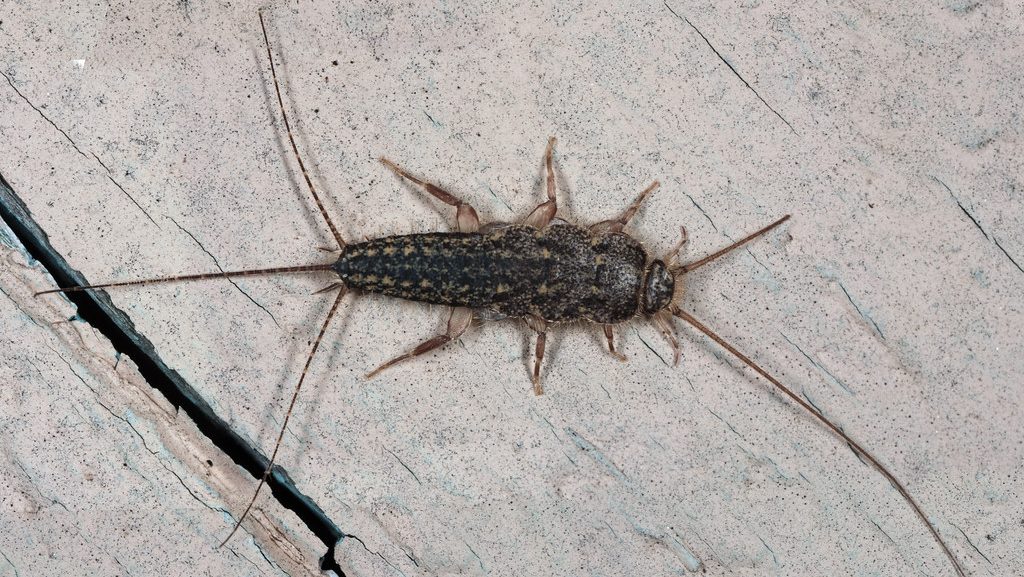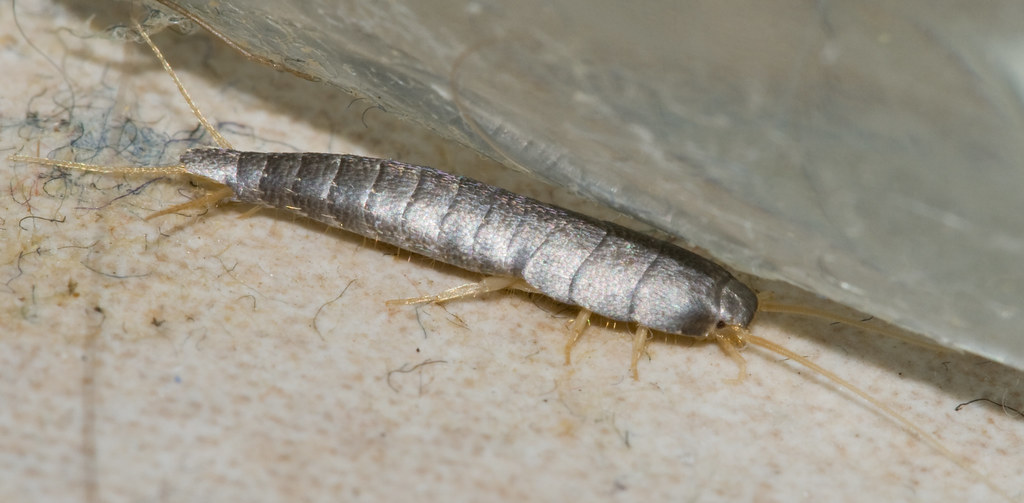Key Takeaways
- Silverfish thrive in humid environments. Reduce moisture by fixing leaks, using dehumidifiers, and improving ventilation.
- Food sources attract silverfish. They feed on paper, glue, textiles, and starches. Proper food storage and cleanliness help prevent infestations.
- Dark, cluttered spaces provide shelter. Declutter and organize storage areas to limit hiding spots for silverfish.
- Prevention is key. Seal entry points, control humidity, and maintain proper sanitation to avoid infestations.
- Traps and insecticides help control infestations. Use sticky traps or insecticides like boric acid or diatomaceous earth to target silverfish.
 Silverfish are small household pests that can be disturbing to find scurrying across your bathroom floor or in the corner of your kitchen cabinets. Although they are relatively harmless to humans, silverfish can damage paper, books, wallpaper, and even clothing due to their diet of starchy materials. If you’re wondering, “Why do I have silverfish in my house?” or “What causes silverfish in the house?“—you’re not alone.
This guide will explore why silverfish infest homes, what attracts them, and how to get rid of them effectively.
Silverfish are small household pests that can be disturbing to find scurrying across your bathroom floor or in the corner of your kitchen cabinets. Although they are relatively harmless to humans, silverfish can damage paper, books, wallpaper, and even clothing due to their diet of starchy materials. If you’re wondering, “Why do I have silverfish in my house?” or “What causes silverfish in the house?“—you’re not alone.
This guide will explore why silverfish infest homes, what attracts them, and how to get rid of them effectively.
What Are Silverfish?
Silverfish are wingless insects that have a distinct metallic sheen and fish-like movements, hence their name. Measuring around ½ to 1 inch in length, these pests are often found in dark, damp areas of the home, such as basements, bathrooms, kitchens, and attics. They prefer living in humid environments and feed on a wide variety of substances, including paper, glue, and starches found in household items. Understanding silverfish behavior and what attracts them to your home is essential in preventing and eliminating infestations.

Not getting a solution?
Get your free pest control estimate today!Why Do I Have Silverfish in My House?
The question “Why are there silverfish in my house?” is one that many homeowners ask when they discover these pests indoors. Silverfish are attracted to homes for many reasons, most of which are related to moisture, food sources, and shelter. Humidity and Moisture: Silverfish thrive in moist, humid environments. If your home has high humidity levels, especially in areas like the bathroom, basement, or attic, it’s likely that silverfish will be attracted to these spaces. Leaky pipes, condensation, and poor ventilation can create the perfect conditions for silverfish to thrive. Food Sources: Silverfish feed on starchy materials, which include paper, glue, and textiles. They are often drawn to books, wallpaper, and clothing made from natural fibers. Kitchens and pantries can also attract silverfish, as they may feed on cereals, flour, and other carbohydrate-rich foods. Clutter and Darkness: Silverfish are nocturnal creatures, which means they are most active at night and prefer to hide during the day. They are often found in dark, undisturbed areas, such as behind furniture, inside storage boxes, or under bathroom sinks. Clutter provides them with the perfect hiding spots and easy access to food sources. Leaky Pipes or Roofs: Leaks that create moisture in your home can attract silverfish. Whether it’s a dripping faucet, a leaking roof, or condensation from pipes, moisture encourages these pests to move in. Fixing leaks and reducing moisture is a key step in preventing silverfish infestations. Cracks and Gaps: Silverfish can enter homes through small cracks around doors, windows, and foundations. Once inside, they will seek out dark areas where they can find food and shelter. Sealing these entry points can help keep silverfish and other pests from entering your home.
Where Are Silverfish Found in My House? Key Areas to Check
Silverfish prefer dark, damp, secluded environments. Understanding exactly where silverfish like to hide is essential for controlling and preventing infestations. Below are the primary locations in your home where you’re most likely to find silverfish, along with detailed insights into why these areas are appealing to them and what signs indicate their presence. 1. Bathrooms Bathrooms provide ideal conditions for silverfish—high humidity, warmth, and plenty of hiding spots. Moisture from showers, sinks, and bathtubs creates an optimal breeding and living environment.Why Silverfish Thrive Here
-
High Moisture Levels: Silverfish are drawn to humidity, making moisture-rich bathrooms ideal, especially post-showers or baths.
-
Secluded Hiding Spots: Cracks behind sinks, toilets, tiles, and inside cabinets offer dark, safe spaces for breeding and hiding.
- Silverfish sightings, especially at night.
- Molted skins in corners, under cabinets, or behind fixtures.
- Small black droppings resembling pepper grains near moisture sources.
Why Silverfish Thrive Here
-
Food Availability: Silverfish are attracted to starches and carbs found in pantry goods.
-
Moisture from Cooking Activities: Hidden moisture behind appliances and under sinks provides ideal conditions for silverfish.
-
Dark Storage Areas: Cabinets, drawers, and shelves offer secluded hiding spots for silverfish infestations.
- Damaged food packaging, especially cardboard or paper-based containers.
- Tiny holes in cereal boxes, bags of flour, or other stored dry goods.
- Shed skins and droppings inside pantry shelves or cabinets.
Why Silverfish Thrive Here
-
High Humidity and Dampness: Moisture retention from rain or poor ventilation makes basements ideal for silverfish.
-
Storage and Clutter: Stored boxes, books, and clothing offer both food and secure shelter.
-
Limited Disturbance: Low human activity allows silverfish to thrive undisturbed in these spaces.
- Yellow stains or damage on books, documents, or paper-based storage.
- Presence of silverfish or their droppings near storage containers or shelving.
- Shed skins scattered near boxes, old clothing, or stored paper items.
Why Silverfish Thrive Here
-
Abundance of Stored Items: Books, old clothes, cardboard, and insulation offer shelter and food for silverfish.
-
Darkness and Isolation: Attics are undisturbed and dark—perfect conditions for silverfish to thrive.
-
Insulation and Fabrics: Fiberglass insulation and stored textiles attract silverfish with their organic material content.
- Small irregular holes in stored fabrics, cardboard boxes, or insulation materials.
- Presence of silverfish droppings and molted skins around boxes or furniture.
- Yellowing or brownish stains on paper goods and stored clothing.
Why Silverfish Thrive Here
-
Natural Fabrics and Starch: Clothing made from cotton, silk, linen, and rayon—especially when starched—attracts silverfish.
-
Darkness and Warmth: Closets provide a consistently dark, warm, and quiet environment for silverfish to nest.
-
Storage Boxes and Paper Items: Items like shoeboxes, gift wrap, and cardboard offer shelter and food for silverfish.
- Small holes or irregular feeding marks on clothing, especially natural-fiber garments.
- Molted skins or droppings found on shelves or floors inside closets.
- Damage to stored paper goods or cardboard storage boxes.
Why Silverfish Thrive Here
-
Stored Cardboard and Paper: Garages often hold cardboard boxes and newspapers, which silverfish feed on.
-
High Humidity and Temperature Variation: Fluctuating temperatures and moisture due to poor ventilation make garages ideal habitats.
-
Limited Human Activity: Silverfish thrive in undisturbed spaces like garages, where human activity is minimal.
- Damage or discoloration to stored cardboard boxes or newspaper stacks.
- Droppings resembling black pepper scattered near stored materials.
- Molted skins near storage areas or corners of garage spaces.

How to Get Rid of Silverfish
Once silverfish have made their way into your home, getting rid of them requires a combination of sanitation, moisture control, and preventive measures. Here are some effective strategies to eliminate silverfish and prevent future infestations: Reduce Humidity: Since silverfish thrive in moist environments, reducing the humidity in your home is the first step to getting rid of them. Use dehumidifiers to lower moisture levels. Ensure proper ventilation by using exhaust fans, particularly in kitchens and bathrooms. Fix any leaky pipes or dripping faucets to prevent additional moisture buildup. Store Food Properly: Silverfish are attracted to starchy foods, so it’s important to store dry goods like flour, cereals, and pasta in airtight containers. Keep your pantry clean and organized to make it harder for silverfish to find food sources. Seal Entry Points: Check your building for cracks, gaps, or other openings that silverfish could use to enter. Block these entry points with caulk or weatherstripping to reduce the likelihood of future infestations. Pay special attention to areas around windows, doors, and foundations. Eliminate Clutter: Silverfish love to hide in dark, cluttered spaces. By reducing clutter in storage areas, closets, and basements, you can limit their hiding places. Keeping items in plastic containers with tight-fitting lids makes it more difficult for silverfish to access them. Use Traps or Insecticides: There are commercial silverfish traps and insecticides available that can help control an infestation. Place sticky traps in areas where silverfish are commonly found, such as bathrooms or basements. Insecticides containing boric acid or diatomaceous earth can also be effective in eliminating silverfish. Follow product instructions carefully when using these treatments. Silverfish are a nuisance, but with the right approach, you can prevent and eliminate them from your home. By addressing the causes of silverfish infestations and implementing effective solutions, you can keep your home pest-free and protect your belongings from damage.If you feel things have gone out of control, it is advised to contact pest control professionals. Our team can provide a customized approach to protect your home effectively.
Visit our Species, Control, and DIY Guide sections for additional resources on silverfish and ways to tackle a silverfish infestation.





